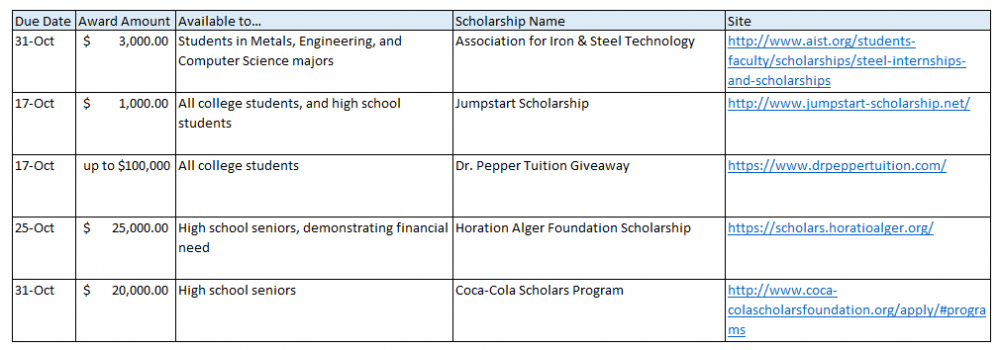5 Fall Financial Aid Wins
Fall is a great time to get a head start on college financial aid. Here are five steps we recommend taking over the next few weeks to help set you up for success in the coming years!

File the FAFSA
The Free Application for Federal Student Aid (FAFSA) opens October 1. This is the gateway to the majority of financial aid at universities, regardless of household income. All students attending college next year should file as close to October 1 as possible, even if they haven’t seen benefits from the FAFSA in the past. With a completed FAFSA, college financial aid offices can adjust aid when surprise circumstances, like job loss or family illness, arise.
If you’d like help filing the FAFSA, stop by one of our workshops! We’re partnering with the Allen County College and Career Coalition to offer a series of FAFSA and scholarship-related events. Check our upcoming events page in the coming weeks for more information.
Get Plenty of Sleep

Half of all college students report some daytime tiredness. All-nighters, midnight energy drinks, and early morning classes can certainly take their toll on how well you perform academically. Poor rest habits are also linked to an increase in physical injuries and worsened mental health.
Students who demonstrated good sleep habits, like getting at least eight hours per night, napping, and waking up at a reasonable time received a 3.24 GPA, but students with poor sleep habits came in a half point lower – at a 2.74 GPA1.
A higher GPA can lead to larger scholarship awards from your university, potentially saving you thousands of dollars over the next few years. For example, IPFW awards up to $4,000 annually for students who achieved a 3.2 GPA in high school. Over four years, that can be a $12,000 gift for good grades. This $12,000 comes out to about a year of tuition! Other colleges offer very comparable programs – just check financial aid pages.
Don't Forget the Scholarships
Various scholarship committees give awards throughout the year, so there are always more opportunities. If you won any awards in the past, now may be a good time to revisit those scholarships. Is the same award offered, and do you qualify again?
Keep checking your favorite sources, and contact one of our Youth & College Advisors for help with finding and applying for scholarships!
Here are 5 scholarships ending in the month of October – there are plenty more available at the Department of Labor scholarship site!

College Visits
All high school students are encouraged to visit colleges in the fall. Why so early? To look at campuses, meet professors, establish academic relationships, meet students, learn about financial aid, browse the campus bookstore, try out the food… there are a lot of reasons! Visiting now means you can build out a “favorites” list, calculate your expected costs and get applications in early.
Students already in college can take advantage of college visits, too. One in three students transfer, according to recent research. This study indicates that transferring may be more costly than staying at your first school, but you can reduce many of these costs by making that sure all of your credits will transfer, your financial aid package will be better at your new school, and that your graduation date won’t be altered2. Work directly with admissions staff, the registrar’s office, and department leaders to make the transfer smoother. It can take a lot of planning, but fall is the time to start if you want to make the move for next year.
If you’re thinking about grad school after finishing your bachelors, take fall break or a three-day weekend to meet with faculty in your field. Scheduling a time to see their work and asking about opportunities to contribute can go a long way in establishing those relationships!
Register for Classes
Most major universities open registration in October or November, and classes can fill up very quickly. Some items to consider:
- Register for classes that are impactful to your major and degree plan. If you are thinking about graduate school, it might be more beneficial to take a tough course instead of that PE Tree Climbing class. Alternatively, if your GPA needs a boost, picking an elective in a comfortable subject could be helpful.
- If one of your required classes is already full, schedule a time to meet with your academic advisor. It is possible that they can manually add you to the course if it will significantly affect your ability to graduate on time.
- Make sure your bill is paid in full before registration opens. An unpaid bill may delay your ability to register, causing you to miss required classes. This can cause a lot of stress! If you aren’t sure where to turn, speak to your financial aid office, or talk with one of our College Funding Advisors to discuss your options.
Action Plan
- File the FAFSA.
- Get plenty of sleep to get better grades.
- Apply for some scholarships.
- Look into all your college options, especially if you’re a high school student.
- Register for classes on time.
If you have any questions, please contact our Youth & College Support Team at 800.825.3641 ext. 8265. We’d love to work with you to achieve your academic goals!
Have a great rest of the semester!
